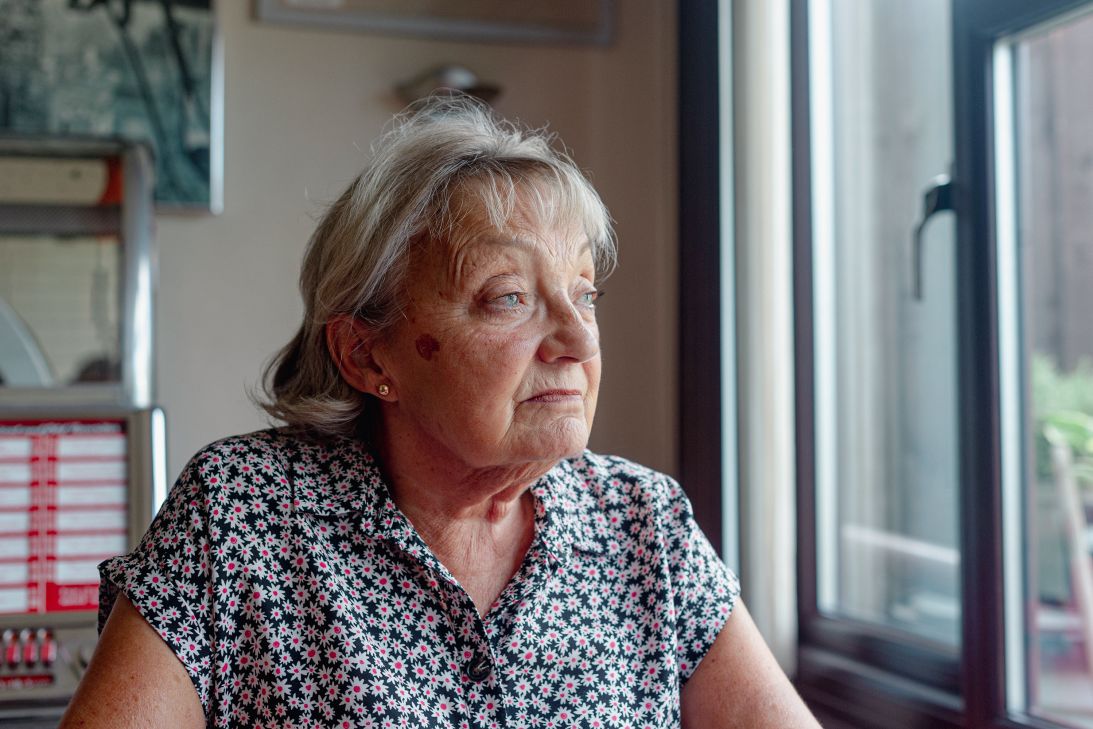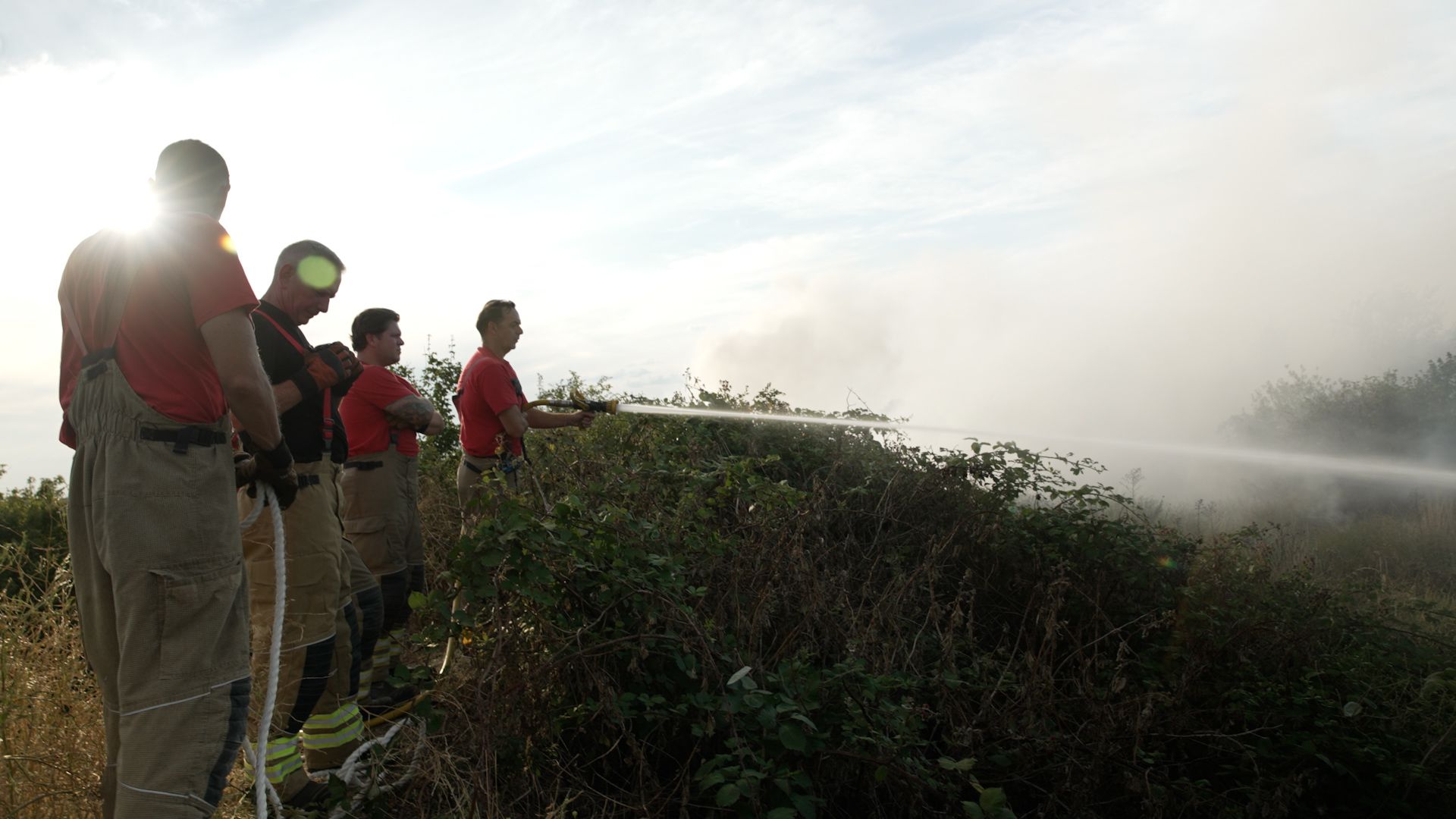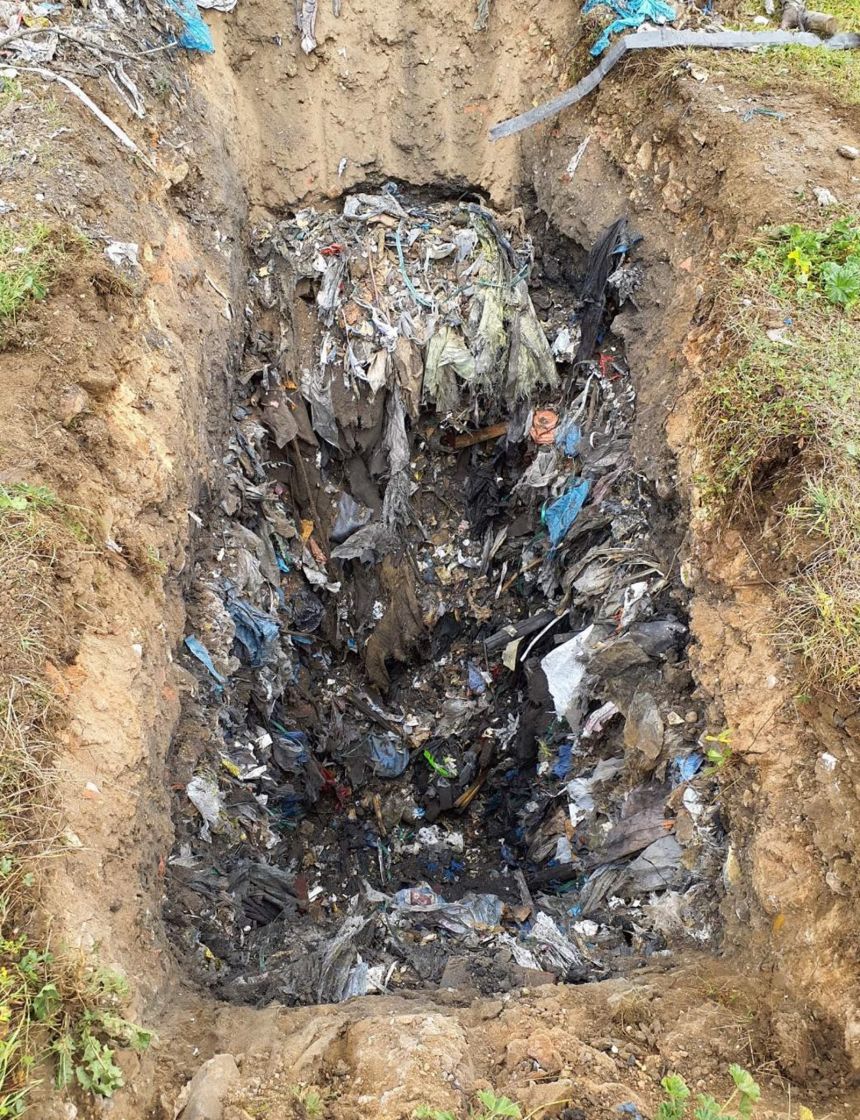RAINHAM, East London
—
Pauline Claridge lives near a volcano, but this one doesn’t spew lava; it churns out thick, noxious-smelling smoke and it’s made of trash.
Arnolds Field landfill, just half a mile from Claridge’s home in Rainham, is an undulating swatch of scrubby land spanning roughly 40 acres. Locals know it as the “Rainham volcano” because every year, when the weather heats up, it bursts into flames, sending plumes of acrid smoke over nearby homes, parks and schools.
Claridge, who has the chronic lung condition COPD, can tell when the landfill is on fire. “It’s just an awful, rancid smell,” she said. Her COPD was not caused by the fires but she believes it’s severely exacerbated by them.
As soon as she and her husband Stan catch a whiff of the familiar, toxic-smelling scent, they rush to switch on fans and humidifiers and shut all their windows, even in the stifling heat of summer. It’s a pattern repeated throughout the warm months.
The landfill is “a volcano, and you’re just waiting (thinking) when’s it going to go?” Claridge said. “It’s an unbearable way to live.”
Arnolds Field is a smoldering mystery. For more than a decade it was used as an illegal waste dump. No one knows exactly what lies beneath the ground here — the trash is mostly concealed beneath grass and shrubs — nor do they know how far down it goes. Some believe it is at least three stories deep.
Whatever lurks beneath creates heat as it decomposes, causing fires that smolder underground and frequently burst into flames on the surface. Arnolds Field has caught fire around 160 times since 2020, according to the London Fire Brigade.
Residents report constant running noses, headaches and sore throats. The bigger, more frightening concern, however, is the potential long-term impact of the smoke. “You have this sort of mystery around breathing it in and what it will do to you,” said Pheobe-Jo White, a 17-year-old who lives with her family near the landfill.
What’s unfolding in this corner of London is not unique.
Humanity produces ever-increasing amounts of trash, only a sliver of which is recycled. The vast majority ends up in landfills often located in low-income communities lacking the power to push back against the noise, air pollution and choking smoke that often accompany them.
In Rainham, a London suburb with significant pockets of deprivation, residents feel trapped in a cycle of inaction. Everyone they approach for help points a finger at someone else.
Arnolds Field is privately owned and local and national authorities say they have limited powers to act. The landowner has said unwieldy bureaucracy, and the sky-high expenses of navigating it, stand in the way of a clean-up.
“No one seems to want to take responsibility for it or deal with the problem,” said Donna Clark, another local resident. Years pass, nothing happens, and the fires keep burning.
For Claridge, Clark and their neighbors, it’s a living nightmare.

On an oppressively hot Friday in July, plumes of smoke curl up from Arnolds Field. Children play cricket in the park alongside it. Sirens pierce the afternoon peace.
London has been baked by rolling heat waves this summer, which almost always spells bad news in Rainham.
Four fire engines and around 25 firefighters show up, closing the busy highway next to the landfill. They’re forced to wait around an hour for a 100-foot turntable ladder to be sent from the other side of London.
Firefighters are no longer allowed to set foot on Arnolds Field. A canister exploded under the extreme pressure generated by the heat of the fire and narrowly missed a firefighter a few years ago, but even more concerning are the “voids” created underground as waste smolders, making the land dangerously unstable. One wrongly placed foot could end in disaster.
<div data-uri="cms.cnn.com/_components/video-resource/instances/cmeblen1e0001356qp4gmyfcw@published" data-component-name="video-resource" data-editable="settings" class="video-resource-elevate" data-fixed-ratio="16×9" data-canonical-url-path="" data-parent-uri="cms.cnn.com/_components/video-resource/instances/cmebl9in30000356nb738w5h8@published" data-video-id="mee23c54c40740aa607ea7a439bae880f08f7cc8f6" data-media-id="mee23c54c40740aa607ea7a439bae880f08f7cc8f6" data-bolt-id="b2605814-4beb-5a59-80fa-1d4c27fc876b" data-live="" data-analytics-aggregate-events="true" data-custom-experience="" data-asset-type="hlsTs" data-auth-type="none" data-content-type="uploaded-clip" data-medium-env="" data-autostart="disabled" data-show-ads="false" data-source="CNN" data-featured-video="true" data-headline="CNN was at the scene when the landfill caught fire" data-has-video-player="true" data-description="" data-duration="01:10" data-source-html='<span class="video-resource__source"> – Source:
<a target="_self" href="https://www.cnn.com/" class="video-resource__source-url">CNN</a>
</span>' data-fave-thumbnails='{"big": { "uri": "https://media.cnn.com/api/v1/images/stellar/prod/laura-and-firefighters-rushes-00-08-25-02-still001.jpg?c=16×9" }, "small": { "uri": "https://media.cnn.com/api/v1/images/stellar/prod/laura-and-firefighters-rushes-00-08-25-02-still001.jpg?c=16×9" } }' data-vr-video="false" data-show-html="” data-byline-html='<div
data-uri=”cms.cnn.com/_components/byline/instances/cmebl9it60004356ngtg1sto3@published”
data-component-name=”byline”
class=”byline-elevate vossi-byline”
data-editable=”settings”
>
</div>’ data-timestamp-html='<div
class=”timestamp-elevate vossi-timestamp”
data-uri=”cms.cnn.com/_components/timestamp/instances/cmebl9ise0003356nz011hhyq@published”
data-editable=”settings”
>
<div class=”timestamp__container”>
<span class=”timestamp__time-since” data-first-publish=”2025-08-15T10:00:46.788Z” data-last-publish=”2025-08-15T10:00:46.788Z”></span>
<span class=”timestamp__expand-btn”></span>
</div>
<div class=”timestamp__details”>
<div class=”timestamp__published”>PUBLISHED Aug 15, 2025, 6:00 AM ET</div>
</div>
</div>’ data-check-event-based-preview=”” data-is-vertical-video-embed=”false” data-network-id=”” data-publish-date=”2025-08-14T16:03:54.349Z” data-video-section=”climate” data-canonical-url=”” data-branding-key=”” data-video-slug=”london-rainham-lanfill-firefighters-vignette” data-first-publish-slug=”london-rainham-lanfill-firefighters-vignette” data-video-tags=”” data-breakpoints='{“video-resource–media-extra-large”: 660}’ data-display-video-cover=”true” data-details=””>


As they survey the blaze, the firefighters say they’ve been called out to the landfill almost every day, recently. It’s a frustrating and expensive exercise.
“The fires are distressing for the local community and are putting firefighters at unnecessary risk,” said a spokesperson for the London Fire Brigade.
For most people in Rainham, the firefighters are among the only heroes of this story. “Frankly, I don’t know what we’d do without (them),” said Shaun Newton, a resident and steering group member of the volunteer organization Rainham Against Pollution. But it’s a huge drain on their time. “One firefighter said to us, ‘I joined the Fire Brigade to save lives, not to extinguish people’s burning rubbish.’”
Arnolds Field has a troublesome history.
Originally a gravel quarry in the 1960s, it was used as a legally authorized landfill from 1967. In 1998, the site was purchased by the now-dissolved company North London Developments. Planning permission was given in 2000 to turn the land into community woodland, but instead the site was used as a trash dump, with reports of truckloads of waste being illegally emptied onto the site.
In October 2004, Havering Council, the local government body for the Havering borough, issued an enforcement notice, demanding the owner stop adding waste to the site or face heavy fines. But dumping continued.
The story took an unexpected twist in 2011, when police discovered a network of subterranean shipping containers at the landfill being used to grow cannabis. They also found handguns, an AK-47, two sawn-off shotguns, six petrol bombs and around $30,000 in cash, according to local media reports.
The owner of the landfill at the time, John Reilly, previously a director of North London Developments, received a 12-year prison sentence for drugs and weapons offences.
Through it all, the dumping continued, with significant amounts of waste added to the site between 2012 and 2016, according to Havering Council.
The site was purchased at auction in 2017 by Jerry O’Donovan, the owner of an equipment hire company. His intention was to repurpose some of the landfill to store his machinery and clean up the site, his representative told residents at a 2023 emergency meeting about the fires.
But his plans bumped up against the expensive reality of dealing with whatever mysteries lie within this smoldering trash mountain.

An early sign of the hazards posed by Arnolds Field came in 2011.
William Knowlden, then 11 years old, was riding his bike across the lumps and bumps of the landfill. He lost control, fell and felt searing pain. The heat of the ground had fused parts of his shoes to his flesh.
He needed a skin graft on both ankles and was under the care of a hospital burns unit for more than a year, said his mother, Nicola Knowlden. It was a shock. There was “not even a ‘keep out’ or ‘danger’ sign” on the site, she said.
The landfill is now closed off, with entrances obstructed by large concrete blocks and tall, forbidding gates.
More than a decade on from William’s accident, there are still huge unknowns about its potential dangers — although recent analyses have shed some light on what’s concealed here.
In 2023, an engineering company dug a series of trenches and boreholes up to 16 feet deep, unearthing a jumble of waste, including tires, plastic bags, timber, polystyrene and canisters. It found lead, a potent neurotoxin that can affect brain development, as well as benzo(a)pyrene and asbestos, known human carcinogens.
It’s been hard, however, to connect what’s in the landfill to impacts residents say it is having on their health.
Havering Council commissioned a series of studies on air pollution from the site. They found periodic spikes in pollutants like PM2.5 — linked to conditions such as cancer and dementia — but the overall, average pollution levels were below the annual guidelines set by the UK and World Health Organization. Health data analyses found no increased risk of certain cancers in Rainham compared to the surrounding area, and only a “modest” impact on the use of healthcare services on fire days.
The upshot was Havering Council’s decision last year not to designate Arnolds Field as “contaminated” land, a label that would have given the council more legal powers to force a clean-up.
To qualify as contaminated, the pollutants on the site must be proven to be harming human health or the environment. “It didn’t at the time, in our view, meet the definition,” said Ray Morgon, the leader of Havering Council.
The decision was a gut punch to many residents who say their lived experience contradicts the idea the smoke is benign.
Claridge says she is able to walk short distances when away from home, but in Rainham often struggles with the few steps between her bedroom and bathroom. Shaun Newton’s wife spent 10 days in the ICU last month with double pneumonia, which they believe was brought on by smoke from the fires. Clark says she and her family suffer constant sore throats when the site burns.
<div data-uri="cms.cnn.com/_components/video-resource/instances/cmebhyg170001356q44hs1rzw@published" data-component-name="video-resource" data-editable="settings" class="video-resource-elevate" data-fixed-ratio="16×9" data-canonical-url-path="" data-parent-uri="cms.cnn.com/_components/video-resource/instances/cmebhmbr10000356kkptk0vqw@published" data-video-id="me4ebae25e32b19a7eb1f7507da548e53bddd86f44" data-media-id="me4ebae25e32b19a7eb1f7507da548e53bddd86f44" data-bolt-id="5c8f601c-c3b2-52fc-b2fe-221f0266ed35" data-live="" data-analytics-aggregate-events="true" data-custom-experience="" data-asset-type="hlsTs" data-auth-type="none" data-content-type="uploaded-clip" data-medium-env="" data-autostart="disabled" data-show-ads="false" data-source="CNN" data-featured-video="true" data-headline="Rainham resident Pauline Claridge lives near the landfill site." data-has-video-player="true" data-description="" data-duration="01:25" data-source-html='<span class="video-resource__source"> – Source:
<a target="_self" href="https://www.cnn.com/" class="video-resource__source-url">CNN</a>
</span>' data-fave-thumbnails='{"big": { "uri": "https://media.cnn.com/api/v1/images/stellar/prod/pauline-00-04-19-10-still001.jpg?c=16×9" }, "small": { "uri": "https://media.cnn.com/api/v1/images/stellar/prod/pauline-00-04-19-10-still001.jpg?c=16×9" } }' data-vr-video="false" data-show-html="” data-byline-html='<div
data-uri=”cms.cnn.com/_components/byline/instances/cmebhmbtm0007356k7kvimrtl@published”
data-component-name=”byline”
class=”byline-elevate vossi-byline”
data-editable=”settings”
>
</div>’ data-timestamp-html='<div
class=”timestamp-elevate vossi-timestamp”
data-uri=”cms.cnn.com/_components/timestamp/instances/cmebhmbtf0003356kx9e3eyb4@published”
data-editable=”settings”
>
<div class=”timestamp__container”>
<span class=”timestamp__time-since” data-first-publish=”2025-08-15T10:00:46.788Z” data-last-publish=”2025-08-15T10:00:46.788Z”></span>
<span class=”timestamp__expand-btn”></span>
</div>
<div class=”timestamp__details”>
<div class=”timestamp__published”>PUBLISHED Aug 15, 2025, 6:00 AM ET</div>
</div>
</div>’ data-check-event-based-preview=”” data-is-vertical-video-embed=”false” data-network-id=”” data-publish-date=”2025-08-14T14:24:11.003Z” data-video-section=”climate” data-canonical-url=”” data-branding-key=”” data-video-slug=”rainham-paulinevignette-digvid” data-first-publish-slug=”rainham-paulinevignette-digvid” data-video-tags=”” data-breakpoints='{“video-resource–media-extra-large”: 660}’ data-display-video-cover=”true” data-details=””>






